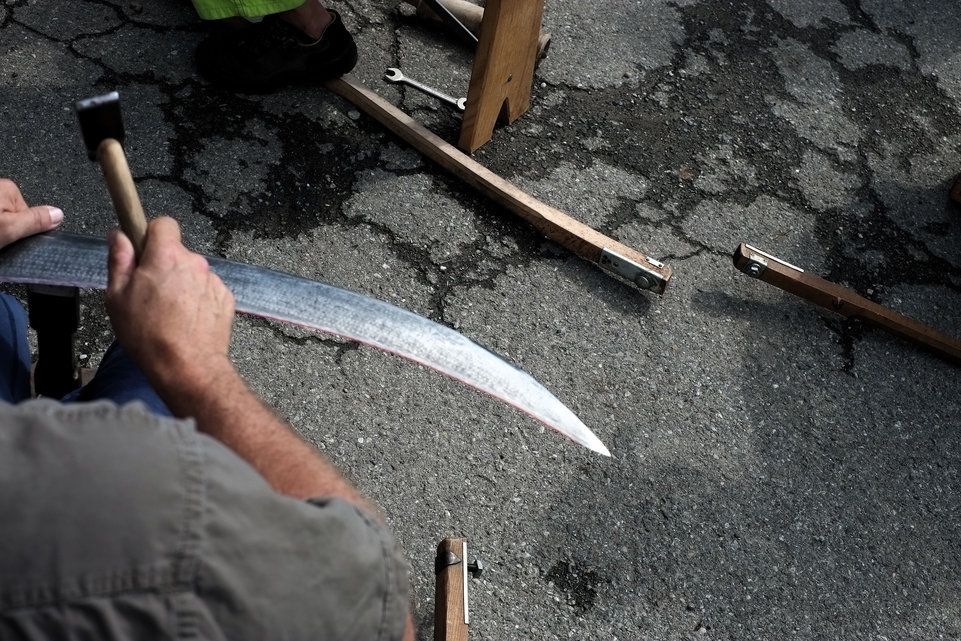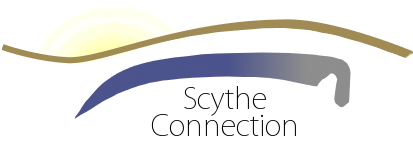 |
When it comes to scythes, the Russians evidently do some things differently (compared with the typical Western European ways). Some of these Russian methods are presented below. Seeing different approaches to familiar problems can benefit one's understanding, creativity, and improvisation potentials.
The drawings appearing below are linked images from the Russian site Pandia.ru and originated from a magazine article titled кoси, кoса by Н. Н. Рoдиoнoв, appearing in the journal Сделай Сам (Знание) 1992-02 [journal name translated as DIY (Knowledge)].
Here is a Russian scythe with a moveable grip. The advantages of such a grip include having a wide range of adjustments possible for different conditions or different users.
The grip is made from a freshly-cut branch that is bent around the snath and secured with a piece of twine. Willow or wild cherry is suggested, with a diameter of 25-30 mm and a length of 350-400 mm. The size of the cutout portion in the middle depends on the diameter of the snath, but is typically around 80 mm, with a depth that's less than half of the branch diameter. A groove is made within the cutout portion, removing the pith and the center of the branch to accommodate bending without breakage. Grooves are carved around each end of the branch to hold the twine in place, once the handle is bent around the snath. A thin piece of rubber (like a scrap from an inner tube) between the grip and the snath will make the connection more secure during use.
Although one-grip snaths seem to be the norm in Russia, this unusual style of two-grip snath was shown as an example from Lithuania:
The blade attachment method (shown in the first drawing above) uses one or two non-adjustable rings in combination with a substantial wooden wedge. This type of wooden wedge is used with a snath having an acutely tapered end. The snath taper is evident in the drawing below which illustrates an alternative grip arrangement:
Having the snath end taper like this, instead of being squared off, will effectively make the blade perform like it has a steeper tang, which can be good for low tangs and/or tall folks. Here's a photo from Peter Vido that shows a blade attached to a tapered snath using a wedge and simple ring (with no set screws):
 |
| From ScytheConnection.com: A snath with a very acutely tapered end. For this arrangement the common set-screw type rings do not work well. However, the simple ring in the picture, held in place by a thick wedge, is a very common way of attaching a blade; many East European and other mowers prefer this method. It is in this manner that most Russian-made blades (the tangs of which are approximately 23-24 degrees) have been used on the straight one-grip snath in Slovakia by tall mowers. For this ring/wedge to hold better, the upper side of the snath’s end remains square, i.e. flat on top, instead of rounded as it would be in order to take the set-screw ring. http://scytheconnection.com/snath-and-blade-fitting/ |
Another method of blade attachment is this clamp, which has a lever arm and a cam:
Peening the blade is done while on the snath or off, with anvils and hammers similar to those used throughout Europe:
The Russian-style peening jig, however, is different. Instead of having a hammered cap that fits over and around a central post, the Russian jig has a hammered post that fits within a round guide:
While the design of this jig is more complex, one apparent advantage is that without a fixed central post, the part of the blade being peened is not butted against anything during the deformation, and therefore would not be dulled by the hammering. This jig has two set screws, one to hold the bottom anvil piece in place, and the other to align the hammer post and keep the up and down movements within limits.
Along with a whetstone, some Russian mowers will carry a smooth, hard steel rod into the field with them to use like a butcher's steel (labeled 2, below).
The function of the steel is to realign the edge and recover some sharpness without having to wear down the edge with the stone. During normal use of the scythe, some of the microserrations in the edge become folded over, dulling the blade. Using the steel can reposition portions of the bent edge back into the original position, restoring the sharpness to a certain extent. Some of the regular honings in the field can be replaced by steeling the edge, effectively prolonging the life of the edge. Another Russian site suggests making this scythe sharpening steel from an old triangular taper file that has been smoothed to remove the file teeth.
Below is a Russian design for grain cradles, made from durable, dry wood, with 3-5 "teeth" (depending on the height of the grain):
1 = Teeth, fitting into 12x12 mm holes in Base
2 = Rawhide straps
3 = Base, 20x20 mm wood, length 350-600 mm
4 = Ring
5 = Twine
The wooden base is firmly attached to the snath with a steel bracket, with one end of the bracket attached to the base using two screws, and the other end of the bracket clamped between the snath ring(s) and the blade tang. The lowest tooth is slightly shorter than the blade, and each upper tooth is 50-70 mm shorter than the tooth below. The teeth are sanded smooth to avoid burrs. Dry rawhide straps are twisted to connect and separate the teeth. Wet rawhide straps are used to help firmly secure the teeth to the base, tightening as they dry. The ring is attached to the snath about 15 cm below the grip, and strong twine is stretched between the teeth and the ring, for additional stability and adjustment potential. All of the teeth should be arranged parallel to the cutting edge of the scythe blade. Fabric or netting can be added,if desired, using a U-shaped frame attached to the snath (not shown).
Sources:
Article titled «Коси, коса...» by Н. Н. Родионов, from the journal Сделай Сам (Знание) 1992-02, pages 45-69
Reprint and images from the article provided by:
Pandia.ru http://www.pandia.ru/text/77/398/102961.php
Original article appears at:
http://zhurnalko.net/=sam/sdelaj-sam-(izdatelstvo-znanie)/1992-02--num45
Wedge attachment photo from Snath and Blade Fitting page at ScytheConnection.com
Painting (upper): Haymaking by Nikolay A. Sergeyev (1855-1919), dated 1887, [Public domain] via Wikimedia Commons
Painting (lower): From Mowing by Pyotr Konchalovsky (1876-1956), dated 1948, linked from Wikipaintings.org







































